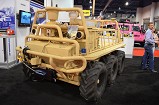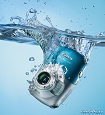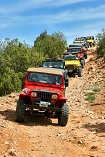 |
||
| > Reader's Photo OX5 by Lockheed Martin |
||
| • ADVERTISE WITH US | ||
| • WHO IS MOAB JEEPER? | ||
Home > Jeep Articles > General - Editorials > Off-Road Photography How-To |
||||||||||||||||||||||||||||||||||||||||||||||||||
 |
||||||||||||||||||||||||||||||||||||||||||||||||||
|
Off-Road Photography How-ToArticle written by TrollDate Added: 05/09/2010 Learn how to make the most of your photos on the trail. |
Our resident photographer, Troll (aka Larry Davis) shares his professional knowledge in this how-to article to help make all of us better photographers during our off-road adventures. Whether you have a simple point and shoot, or a snazzy interchangeable lens camera, you can create amazing photos of your Jeeping adventures through today?s digital technology. |

|
|
One caveat to this article: Do not put yourself in harm's way to get the shot, no matter how tempting it may seem. Zooms are on cameras for a reason and it's better to stand back and zoom in to compose your photo, rather than stand in the way of a 4,000 pound rig that could potentially tip over and squish you like a bug. There is also the possibility of flying projectiles being hurled at your skull if you stand directly behind a Jeep while it is spinning on dirt or rocks. Getting hit in the noggin by a rock would ruin anybody's day. |

|
|
A Little About Troll Troll is an accomplished professional photographer with more than 12 years of experience trekking the globe in search of the perfect shot. Troll has been to 46 states and several countries photographing everything from alpine mountains to offshore powerboats and of course, Jeeps. A few of Troll's larger clients include Morgan Stanley, Tractor Supply Company and Macy's. Troll travels regularly with a team of photographers throughout the world for Morgan Stanley. For several years, Troll has been risking his neck to capture incredible photos of Jeeps for MoabJeeper Magazine throughout the United States. |

|
|
What This Article is About ? Making Better Photos This article focuses on several "rules" of photography Troll uses in his bag of tricks to create a perfect image. Of course, every rule is meant to be broken and this is especially true when it comes to photography and art in general. Rules in photography are more like guidelines and they are by no means set in stone. What follows below are a number rules you can use to make your photos stand out. |

|
|
1. Know your camera. This is not so much a rule as it is a suggestion. If you do not know how your camera operates and are not familiar with its functions, capturing the perfect shot will be a lot more difficult than if your camera is like an extension of your anatomy. Most modern cameras have point and shoot capabilities, whether they are standard omega replicas non-interchangeable lens cameras, or single lens reflex (SLR) cameras. While the point and shoot capabilities of most cameras will do well in the majority of situations, there will be times when these capabilities will fall short and you will be disappointed. Knowing all the ins and outs of your camera is a must if you are going to capture the best photos. Read your manual! |

|
|
2. Get the most camera for your money. The camera you purchase and use on the trail needs to be one that will hold up to the abusive conditions most of us find ourselves in while wheeling. Whether you are venturing through the windswept and dusty Moab desert, the Colorado mountains, or the Louisiana swamps, make sure your camera is up to the task of handling the environment you are putting it in. This does not mean you need to fork over thousands of dollars for a high end pro camera. It just means you need to be aware of the camera's abilities to hold up within your off-roading environment. Some things to ask the salesman are: |

|
i. How dustproof / dirt proof is the camera? Dust and dirt can destroy a camera's inner workings very quickly. Make sure you get a camera that will stand up to the dirt we often find on the trail. It does not matter if you are in a desert dust storm, less commonly known as a haboob (we think this is an interesting word), or a dirty trail in Kentucky, the results can be devastating either way. Many point and shoot and pro level cameras have seals in them to keep the bad stuff out. |

|
b. Is the camera waterproof? Some of your best photos will be taken during rainy conditions. Overcast skies can create the perfect lighting for outdoor photos of Jeeps and if it's raining while you are out there snapping away shots of your buddy's mud slinging action, you had better be sure your camera's body is able to withstand the downpour you are standing in. If not, zap! Your camera's on-board circuitry could be toast and most warranties will not cover you if the camera is not rated to stand up to water and you decide to stand outside with it in a monsoon. |

|
c. Will the camera stand up to bumps? If you have ever thought of the amount of bumping and jarring you go through while on a trail ride, you can well imagine the abuse your camera goes through bouncing around in your Jeep. Make sure the camera you purchase is capable of standing up to all this bouncing around, or get a good padded case to protect it while you don't have it in your hands. Troll failed to heed his own recommendation while wheeling in Moab a couple years ago when he flipped his Jeep and a video camera went bouncing around inside his Jeep. This video camera now records what we call out of focus "drunk video." |

|
|
3. On sunny days, shoot with the sun at your back or from the side. This is a rule you may have learned from your grandparents back in the day when they were taking photos of your family out in front of the house. Gramps would line everyone up staring into the sun to get the "best light" while everyone rolex repliky squints back at the camera. Of course, this did not always lead to the best results of people photos. When shooting Jeeps that don't have eyes, this is the ideal lighting situation in most cases.
Direct sunlight on a Jeep's surface will make its paint shimmer and colors pop out on the photo. Side lighting can lead to interesting contrast and wonderful depth in the photo. |

|
|
4. Get down low and shoot from the Jeep's perspective. Many of your best off-road photos will be the ones where you were at the perspective of the Jeep, not above it. This rule holds true for many subjects in photography, as it brings the viewer of your photos to the same "level" as the subject. In most cases, it is best to be shooting from grill height, or just above hood height to capture the best perspective. In some cases, it is even best to lay down on the ground if you are trying to capture a twisted up suspension, or are accentuating the size of a big obstacle. |

|
|
5. Compose your photo using the "rule of thirds." The "rule of thirds" is a tried and true method of placing subjects within the frame of your photo. Think of your camera's viewfinder as a grid made up of 3 vertical lines and 3 horizontal lines. Most of the time, it is a good idea to place the subject of your photo directly on one of these imaginary lines to get the best composition. In the case of a single Jeep, you will usually want to place the Jeep on the leftmost or rightmost line of the frame dependent upon the travel direction of the Jeep. If the Jeep is going from left to right in front of you, place more of the Jeep in the left part of the frame than on the right to produce a natural and pleasing composition. |

|
|
6. Watch the backgrounds of your photos. One of the biggest mistakes most amateur photographers make is not paying attention to the backgrounds of their photos. Always be aware of what's going on behind the subject you are photographing. If your grandma is sitting on the other side of the trail with your dog Spike, block both grandma and Spike from the frame by positioning the Jeep directly between yourself and them. Sure, everyone loves grandma and the dog, but nobody wants to see them when your buddy is clamoring over that awesome obstacle. |

|
|
7. Frame your photos well. In many cases you will want to fill the entire frame of your photo with a Jeep. This works great for those shots where a gnarly obstacle is being taken. At other times, you will want to shoot an overview of several Jeeps coming down the trail, or maybe a couple Jeeps running together. In every case, try to frame your shot well and make sure everything in your viewfinder is adding to your shot and not taking away from it. |

|
|
8. Balance your photos. Balance is a combination of perspective, composition and framing. Using the "rule of thirds" by placing your subject off center in the photo will usually result in a better shot. Perfectly symmetrical photos where the Jeep is dead center in the frame will almost always lack movement and action and will appear boring. This same rule applies when shooting scenics and landscapes. Always try to shoot more sky or more foreground in your photos and do not place the horizontal horizon line directly in the middle of the frame. |

|
|
9. Position yourself in the right spot. So many great photos are missed because the photographer was standing in the wrong position when the action happened. Most of the time, you will be able to watch at least one Jeep head down the trail and over the obstacle you are trying to capture. Keep an eye on how the Jeep is positioned when it comes to the obstacle and how it overcomes the obstacle. Also pay attention to the size of the obstacle and anything that might get in your way of getting a great photo of the Jeep as it crosses over. Walk to the position that seems to lend itself to the best perspective for the shot and shoot away. |

|
|
10. Pay attention to contrast, color and shadows. Sunny days can bring out vibrant colors and high contrast, but they can also wash out photos and create dark shadows. On sunny days, it is best to shoot in the morning and late afternoon / evening for the best light. Of course, this is not always possible when wheeling. If you have a flash handy on your camera, it may be a good idea to turn it on when you are shooting in the mid-afternoon sun. This is known as "fill flash" and it can really make the colors pop and fill in the shadows created by the overhead sun.
Cloudy days almost always lend themselves to even toned images with nice color saturation and low contrast. A little flash is usually necessary to fill in some of the shadow areas on these days, especially if you are shooting in the woods where the light can be at a premium. Most point and shoot cameras are incapable of capturing photos in dark environments and you may be forced to use the flash in these cases. |

|
|
11. Choose the right lens length. | |
|
Wide angle lenses not only capture more of the scene, but they also tend to distort objects that are close to them, or are at the edges of the frame. Wide angle lenses are generally used to include more of the surroundings of the scene, or to fill the frame when you are close to your subject.
|

|
|
Telephoto lenses (also known as zooms) are used to bring objects closer and fill more of the frame with them. They can also eliminate the surrounding scene and lend more focus on the specific subject you are shooting. A zoom lens will compress the background of your photo and make it seem closer to the subject. This effect works great if you are honing in on your subject and are trying to eliminate everything around it. If you have an SLR camera, you can manipulate the aperture of the lens to throw the background out of focus and show only the subject in clear focus. |

|
|
12. Use the right ISO. ISO is a setting on nearly every digital camera made today and it relates to the sensitivity of the camera?s sensor to light sources. Setting the right ISO outdoors: set the ISO it to its lowest setting (usually 100) when you are outdoors and there is a lot of sunlight. If you set the ISO too high while outdoors, your camera may not be able to compensate for the amount of light reaching the sensor and your shots may appear washed out. On cloudy days, or if you are in the woods, you will want to move the ISO setting up to make the camera?s sensor more sensitive to light. This will help to eliminate camera shake, which happens when your camera tries to make a photo by leaving the shutter open for a long time to gather enough light for the photo. Lots of photos are blurry due to this condition and it?s usually because the photographer did not change their ISO to lessen the amount of time the camera?s shutter is open. |

|
|
13. Be creative. So many photos on the trail look the same. Most people stand in the same positions, shoulder to shoulder in some cases, and wind up with the exact same boring photographs. If you want to make things interesting, try the following suggestions:
|

|
Final ThoughtsAlways look for new and interesting perspectives to make the most of your photos and have fun shooting on the trails. Above all else, be safe and do not put yourself in harm?s way to get the shot. | |
|


